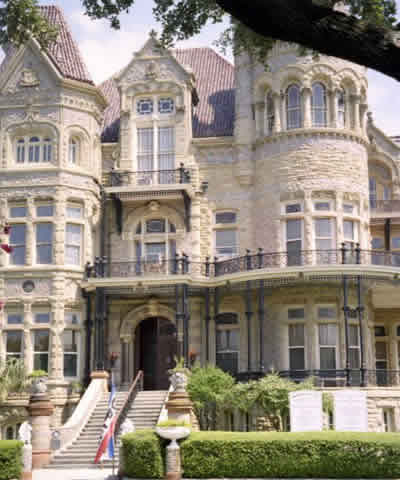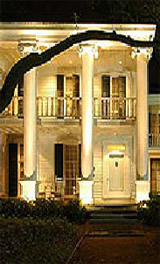 |
 |
 |
|
 |
The Bishop's Palace on Galveston Island is just one of the many attractive architectural examples to be seen just a short drive from Houston, site of the 2008 USITT Annual Conference & Stage Expo.
|
|
|
Galveston Island Offers
Architectural Delights "When cotton was King and Galveston was Queen City of the gulf, prosperous island families built estates that would endure hurricanes, political strife, and the economic recessions." Galveston Historical Foundation. Little respected for its architectural historic significance, the City of Galveston Island, just a short drive south of Houston, is home to a variety of wonderful 19th century structures. It is an easy drive from the site of the 2008 Annual Conference & Stage Expo based in downtown Houston. The city takes extreme pride in its period homes, shops, and opera house, perhaps because of the Great Storm of 1900 when a major hurricane literally wiped clean a portion of Galveston four blocks wide and more than a half mile long. Over 6,000 inhabitants perished on the island and devastation and debris were all that were left of more than 3,600 buildings. However, many noteworthy buildings did endure and are awaiting a visit. The Bishop's Palace, built in 1886 for approximately a quarter of a million dollars, is one of the grand survivors. The pale grey and pink Texas granite and red limestone Richardson Romanesque home was constructed by wealthy attorney Walter Gresham and was originally known as Gresham's Castle. Bishop's Palace, renamed after being purchased as the Diocese of Galveston Bishop's residence (a service it still provides) boasts 11 rare stone and wood fireplace mantels and a magnificent wooden staircase that required 61 craftsmen seven years to complete. The house is an idiot's delight of glorious stained glass windows, intricately carved wood and stone ornamentation, and luxurious Victorian furnishings. The American Institute of Architects has listed the home as one of the 100 most significant buildings in the United States and the Library of Congress has classified Bishop's Palace as one of the 14 most representative Victorian structures in America. Ashton Villa, a marvelous 1859 Italianate mansion, was built by one of Texas' wealthiest men of the mid-19th century, James Moreau Brown, and it set the standard for opulence. The first home constructed of brick in Texas, Ashton Villa was built primarily with slave labor and features 13-inch thick walls to help protect the home from the damp of the Gulf Coast. The house retains much of its original furnishings and the art work of Brown's daughter, Miss Bettie. (If you are fond of ghosts and spirits, it is rumored that Miss Bettie has never left the villa and can be seen on a second floor landing in an appropriately period turquoise gown.) The Michel Menard Mansion, or "The Oaks" as the family named the homestead, was built in 1838 -- a full year before the city was incorporated. An exquisite example of Greek Revival style, the Menard Mansion was actually constructed in Maine and shipped in pieces to Galveston to be placed on a lot well outside of the foul smell and tainted dirt within the growing city's limits. Although not representative of Southern interiors of the time, the house has been furnished with an outstanding collection of Federal and American Empire antiques. The Strand is a unique collection of late 19th century commercial buildings that has been designated a National Historic Landmark District. It was on this street that financial good fortune was displayed in the cast iron-fronted business and retail buildings. While many of the Strand's structures sustained extensive damage in the 1900 Storm, most have returned to their stately charm. Hendley Row, adjoining buildings from 1858 to 1859, are the oldest commercial buildings in Galveston; the 1870 J. S. Brown Hardware Company Building was once home for the largest hardware company south of the Mason Dixon line; and the Rosenburg was the largest dry goods store in Texas in the 1870s. Of note, too, is the difference between the street and the sidewalk levels. The walks were raised so that ladies could step from their carriages without setting food in the mucky crud of the dirt street. The Strand is now a remarkable collection of unique enterprises including Col. Bubbie's Strand Surplus Senter (property masters and designers must avail themselves of the opportunity to actually visit the dusty, cramped emporium of military accoutrement just for the experience!). The East End National Historic Landmark District of Galveston features a variety of distinguished and prime examples of 19th century homes of outstanding detail. The Galveston Historic Foundation provides information on several pleasant walking tours through the district and information, albeit somewhat limited, on every address. Several illustrative exteriors can be viewed at www.pbase.com/lwh/galvestonhomes. Most of these homes and non-residential buildings are in private hands, so you won't be able to view interiors except for several bed and breakfasts; but the exteriors are more than worth the trip. |
The Greek revival Menard Mansion, (below) is owned by Ball State University.  |
|